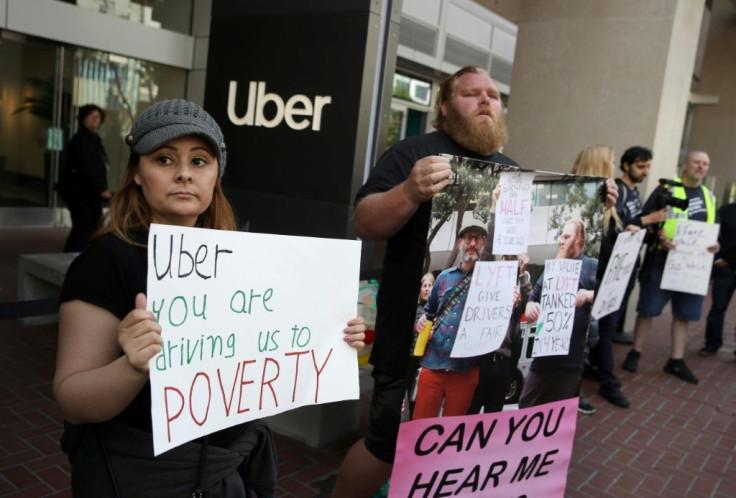Uber's Growth Could Take A Hit Thanks To This Negative Report

Uber Technologies (NYSE:UBER) has underwhelmed ever since the ridesharing giant made a disappointing stock market debut earlier this year. Uber was expected to be a top growth stock because of the industry it operates in, but as it turns out, growth is stalling and losses are mounting.
However, Uber's problems don't end there, as a recent report claims that it is taking a bigger cut from drivers without telling them. Let's see how this report could negatively affect a ride-hailing company that's already under a lot of pressure.
Uber reportedly taking a bigger share
Automotive and transportation-centric website Jalopnik says that it has collected data from nearly 15,000 trips by Uber and Lyft (NASDAQ:LYFT) drivers. From the fare receipts that it collected, Jalopnik says that on average, Uber received 35% of the revenue the drivers generated from their trips.
Uber has disputed the data, saying that the sample size is too small. After all, Jalopnik reportedly collected data on nearly 9,000 Uber trips in the U.S. to arrive at its findings, and the ridesharing specialist reportedly completes 15 million trips daily across the globe.
So anyone reading Jalopnik's report should take it with a grain of salt. However, some of the reactions recorded by the website could fan the driver agitation Uber is facing across the globe to raise pay and provide better working conditions.
For instance, a driver from Texas who sent data of nearly 500 surge fares to Jalopnik said that Uber's cut used to be 20% when he started driving on the platform three years ago but that the ridesharing company now takes a 31% cut on average, and with certain fares Uber takes half of his revenue.
Again, it might not be a great idea to rely on this data and the driver reactions, considering the small sample size. But this does not bode well for Uber in light of the latest driver protests calling for legislation to formalize their employment and the passage of Assembly Bill 5 into law in California.
A double whammy
Lawmakers in California recently passed Assembly Bill 5 (AB5) legislation, which would make Uber and Lyft drqivers, currently classified as independent contractors, employees of the ridesharing companies beginning Jan. 1, 2020.
However, Uber doesn't see itself falling within that framework and will campaign against AB5. Instead, Uber has proposed a $21 hourly minimum wage, paid time off, and injury protection .
But drivers are not too happy with what Uber is offering. They believe that the proposed minimum wage won't be enough for them to make a living, so Uber might have to come back with a stronger offer to appease them.
This could have two implications for Uber. First, the company might have to increase fares in order to pay its drivers a higher wage. Second, it might have to reduce its take of the ridesharing revenue. The problem is, taking either of these two paths could dent Uber's financial performance.
The competitive nature of the ridesharing industry means that Uber doesn't have the luxury to raise fares, as that might push customers away to Lyft. Here's why...
Uber's revenue increased 14% annually in the second quarter of 2019 to $3.16 billion, down from the 20% top-line growth recorded by the company in the first quarter. Bulls will point out that Uber's gross bookings increased 31% during the second quarter to $15.8 billion, which means that customers spent more money on rides and Uber Eats deliveries.
But the higher bookings figure clearly didn't translate into revenue growth. Uber's second-quarter revenue was around 20% of its gross bookings, down from 23% in the year-ago period, which could be attributed to a decline in Uber's take rates.
The take rate is the adjusted net revenue Uber gets as a percentage of gross bookings. The higher the take rate, the less money drivers get to keep. Uber's take rate in the second quarter of 2019 fell to 19%. This metric was substantially higher in the first quarter of 2018, at 23% -- which means that Uber is keeping less money for itself, and that's impacting its top line.
Lyft, on the other hand, is enjoying far greater revenue growth, as it reported a 72% spike in the top line in the second quarter of 2019. Lyft's solid revenue growth can be attributed in part to its higher take rate. The company had a 26% take rate last year, which means that it can afford to pay a higher minimum wage to drivers as compared to Uber without raising fares. Of course, that will hit Lyft's bottom line, but it can grab a bigger market share.
On the other hand, if Uber decides to reduce its take rate to accommodate a minimum wage and other employee benefits that it might have to pay after AB5 was passed into law, without hiking fares and passing on the burden to customers, its bottom-line performance will worsen.
Uber's costs and expenses in the second quarter of 2019 ballooned to $8.65 billion from $3.5 billion in the year-ago period. Its operating loss jumped to nearly $5.5 billion from $739 million in the year-ago period. The operating loss does include $3.9 billion in stock-based compensation and $298 million in driver rewards in connection with the IPO. But even if we exclude those one-time items, the loss seems too big to ignore.
Uber risks slipping deeper into the red if drivers start taking a larger share of bookings or if customers move away because of higher fares, and that would be bad news for the company and the stock.
Harsh Chauhan has no position in any of the stocks mentioned. The Motley Fool recommends Uber Technologies. The Motley Fool has a disclosure policy.
This article originally appeared in The Motley Fool.





















